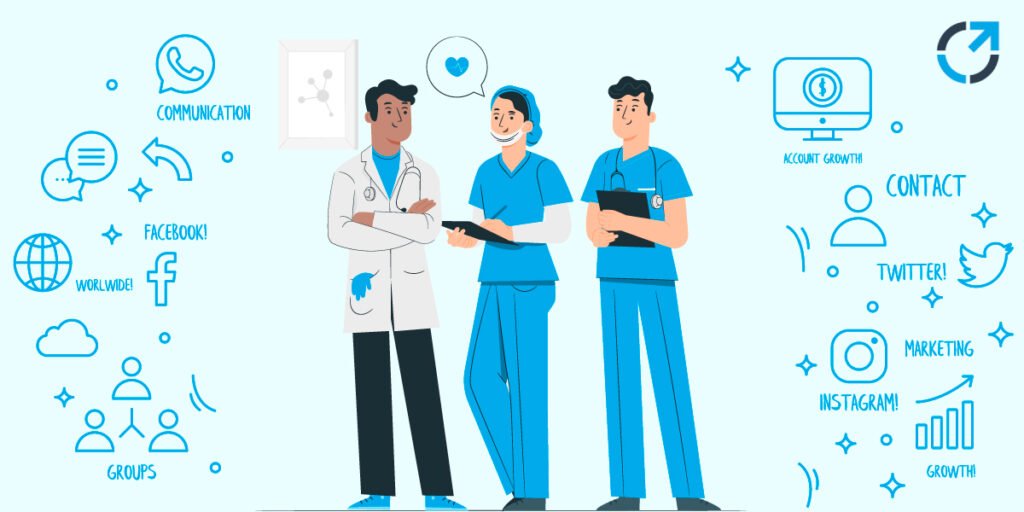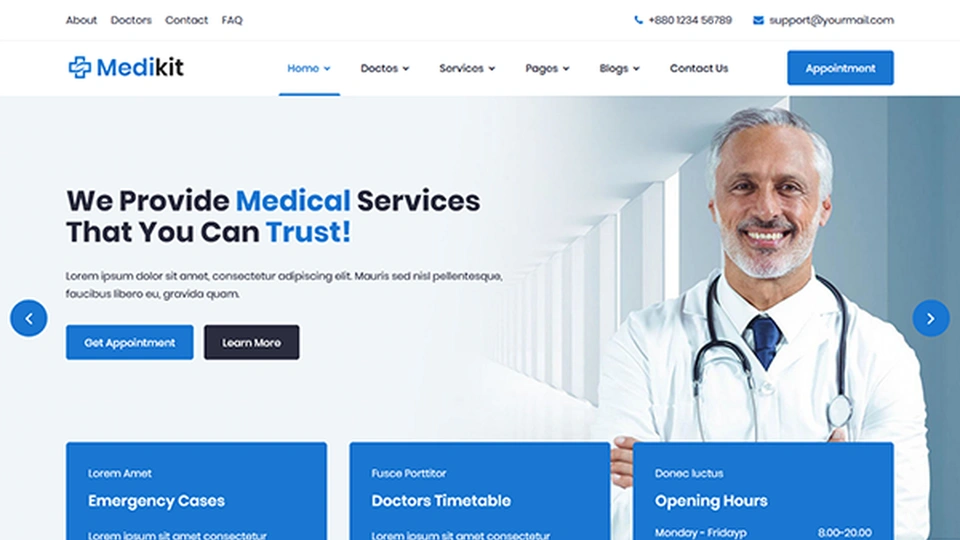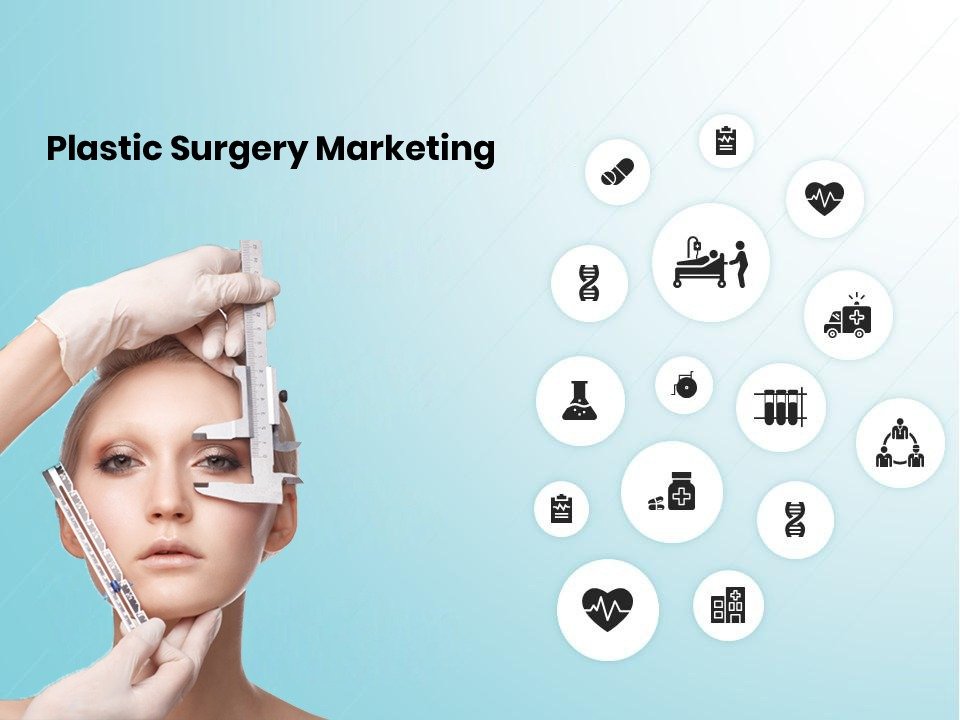What is Healthcare Digital Marketing?
Healthcare digital marketing is the strategic promotion of healthcare services, providers, hospitals, and wellness programs using digital channels. This includes everything from search engine optimization (SEO) and social media engagement to email newsletters and online ads. Think of it as taking your healthcare brand and placing it right where your patients are—online.
In a time when people Google symptoms before seeing a doctor and check online reviews before choosing a clinic, digital marketing isn’t just nice to have—it’s absolutely essential. It bridges the gap between medical expertise and the digital-savvy patient. Whether you’re running a private practice, a dental clinic, or a full-scale hospital, Healthcare digital marketing gives you visibility, credibility, and connection in the crowded healthcare market.
The beauty of digital marketing is in its versatility. Want to educate your community? Start a blog. Want to increase bookings? Launch a paid ad campaign. Want to build trust? Share patient success stories. It all fits under the digital marketing umbrella.
But here’s the twist—healthcare digital marketing has stricter rules. It’s not just about catchy slogans. You need to be transparent, ethical, and accurate while still being persuasive. That balance is what makes mastering healthcare digital marketing both an art and a science.
Why is Digital Marketing Essential in Healthcare Today?
Let’s face it—traditional marketing in healthcare is on life support. Billboards and newspaper ads just don’t cut it anymore. Patients are online 24/7, and the first place they look for medical answers or providers is Google, not the Yellow Pages.
Helthcare Digital marketing gives the industry providers a powerful toolkit to meet patients where they are. Imagine a potential patient searching for “best pediatrician near me.” With the right Healthcare digital strategy, your clinic can pop up at the top of those search results. That’s not magic—it’s smart SEO and location targeting.
The rise of telehealth, online booking systems, and patient portals means the patient journey is becoming increasingly digital. If your healthcare business isn’t online—or isn’t visible—you’re missing out on countless opportunities to serve and grow.
Moreover, today’s patients are informed and empowered. They want answers, options, and trust before making health decisions. A strong digital presence helps you deliver all of that. From educational blog posts to real-time chat support, Healthcare digital marketing helps you provide value before a patient even steps into your office.
Simply put, digital marketing is the heartbeat of patient acquisition and retention in 2025.

Understanding the 2025 Digital Landscape
Trends Shaping Healthcare Marketing in 2025
In 2025, digital marketing strategy for healthcare isn’t just evolving—it’s accelerating. Thanks to advances in technology, changing patient expectations, and a more competitive digital arena, staying ahead of the curve is no longer optional.
Here are some trends that are shaping the health digital marketing scene:
- Hyper-personalized content: Patients expect content tailored to their conditions, demographics, and even behaviors. AI-driven platforms now help healthcare marketers deliver custom experiences in real time.
- Voice search optimization: With the rise of smart speakers and mobile assistants, more people are using voice to ask health questions like “What are the symptoms of high blood pressure?” Optimizing for voice search is a game-changer.
- Video-first strategy: Short-form educational videos, virtual health Q&As, and live webinars are dominating engagement. Video content is 12x more likely to be shared than text or image-based content.
- Zero-click searches: Google often answers queries directly in search results. Ranking for featured snippets is now more important than ever.
- Health inclusivity: Patients want to see diversity and representation. Brands that embrace inclusive messaging resonate more deeply with modern audiences.
Adaptation is the name of the game. If you’re still stuck on what worked in 2019, you’re already behind. The digital landscape in 2025 rewards innovation, empathy, and agility.

Role of AI and Automation in Modern Campaigns
Artificial intelligence is no longer science fiction—it’s your new marketing assistant. From chatbots scheduling appointments to AI algorithms predicting patient behavior, automation is transforming how healthcare marketing works.
Here’s how AI is becoming a cornerstone of Healthcare digital marketing strategy for healthcare:
- Chatbots for patient support: Automated chat systems provide instant answers to FAQs, book appointments, and guide users through services 24/7.
- Predictive analytics: AI tools can analyze user behavior to forecast what content or service a patient might need next—allowing hyper-targeted outreach.
- Content generation and personalization: Platforms like GPTs are helping marketers create blog posts, emails, and ads tailored to each segment.
- Ad campaign optimization: Machine learning improves ROI by adjusting bids and targeting in real time across platforms like Google Ads and Facebook.
- Voice and image recognition: Tools are helping identify symptoms from photos and voice recordings, supporting virtual care and diagnostics.
The key? Automation doesn’t replace human empathy—it enhances it. By taking over repetitive tasks, AI frees up your team to focus on creative, strategic, and human-centered efforts. The future of healthcare digital marketing is smart, fast, and automated—but always personal.
Building a Strong Digital Foundation
Creating a Responsive, Patient-Centered Website
Your website is your digital front door. And in 2025, if it’s not responsive, lightning-fast, and user-friendly—you’re losing patients before you even meet them.
Think about it: a potential patient clicks your link, and your site takes more than 3 seconds to load. They bounce. Or worse, it’s not mobile-friendly, and they can’t read your content. They leave. First impressions matter more than ever.
A patient-centered website needs to do more than look pretty. It should:
- Load in under 2 seconds on all devices
- Adapt seamlessly to mobile, tablet, and desktop
- Feature intuitive navigation—no one should get lost trying to book an appointment
- Include accessibility features, like screen reader compatibility and text scaling
- Provide clear calls-to-action (“Book Now,” “Chat with a Nurse,” “Find a Specialist”)
- Integrate with patient portals, online booking systems, and telehealth services
And don’t forget trust signals. Patients want to see doctor bios, certifications, patient testimonials, and health accreditations. Transparency builds credibility.
In 2025, your website isn’t just a brochure—it’s a patient engagement tool. It should educate, convert, and support patients throughout their journey. If you invest anywhere this year, let it be your website—it’s the foundation of your entire Healthcare digital marketing strategy for Healthcare.

Importance of SEO for Healthcare Providers
On-Page SEO Best Practices
Search Engine Optimization (SEO) is the backbone of visibility in healthcare digital marketing. On-page SEO, in particular, is the stuff that makes your website pages irresistible to Google—and to your patients. It’s all about optimizing individual pages so they rank higher and drive more relevant traffic.
So, what’s the secret sauce?
- Targeted keywords: Start by researching what potential patients are searching for. Phrases like “top cardiologist in Miami” or “pediatric urgent care near me” are gold. Naturally weave these into your headings, paragraphs, and metadata.
- Clear, structured content: Use H1s, H2s, and bullet points to make content scannable. Keep it conversational and helpful—Google loves content that solves problems.
- Internal linking: Link to related pages within your site. This keeps users engaged and signals to Google that your site is well-structured.
- Image optimization: Use high-quality images with descriptive file names and alt text. Patients may find you through image search.
- Mobile-first design: Google’s mobile-first indexing means your mobile site performance directly affects your ranking.
Also, don’t forget about meta descriptions and title tags—they may not directly impact ranking but they significantly affect click-through rates. Think of them like your healthcare digital marketing elevator pitch.
When done right, on-page SEO makes your site both user-friendly and search engine-friendly. It’s a win-win.
Off-Page SEO Strategies
Off-page SEO is all about reputation and relationships. It focuses on what happens outside your website that boosts your authority and trustworthiness. In healthcare, trust is everything—and off-page SEO helps build it.
Start with backlinks. These are links from other websites to yours, and they act like votes of confidence in Google’s eyes. The more high-quality, relevant sites link to you, the better. Think:
- Guest blogging on reputable health forums or sites
- Getting mentioned in news articles or local press
- Partnering with universities or health organizations for content
Then there’s online directory listings. Make sure your clinic or practice is listed consistently across platforms like Healthgrades, Zocdoc, Yelp, and Google Business Profile. Inconsistent information confuses both users and search engines.
Social signals also matter. While likes and shares may not directly boost rankings, they indicate engagement and can drive traffic. When people are talking about your content online, Google notices.
And don’t overlook review sites. Patient reviews on trusted platforms contribute to your healthcare digital marketing reputation. Google considers these when ranking local results. More on that soon.
Off-page SEO is the digital equivalent of word-of-mouth. Build strong connections, get recommended, and the search engines—and your patients—will come to you.
Local SEO for Clinics and Hospitals
If you run a local practice, local SEO isn’t optional—it’s mission-critical. It helps your clinic appear when someone nearby searches for care. For example, “dermatologist near me” or “24/7 urgent care in Boston.”
The foundation of local SEO is your Google Business Profile (GBP). Make sure it’s:
- Fully filled out with accurate contact info
- Featuring professional photos of your clinic/staff
- Updated regularly with hours and holiday schedules
- Showcasing positive patient reviews
Next, get listed in local directories and ensure your NAP (Name, Address, Phone Number) is consistent everywhere. Inconsistencies kill your local ranking chances.
Use location-based keywords in your website content: city names, neighborhood references, even landmarks. Create specific service pages like “Physical Therapy in Downtown LA” rather than lumping everything into one generic page.
Another pro move? Encourage patient check-ins and photo uploads to your GBP. This boosts engagement and trust for potential new patients.
With the surge of mobile health searches, local SEO ensures you’re not just online—you’re findable when and where it matters most.
Read Also : Marketing trends in healthcare
Content for Healthcare digital marketing strategy
Blogging and Educational Resources
Content marketing is how you win trust before patients even meet you. A well-written blog post can answer questions, dispel myths, and position your brand as a helpful authority.
Start with a blog. But not just any blog—create content that solves real problems. Think about common patient questions like:
- “What are early signs of diabetes?”
- “How to treat seasonal allergies at home?”
- “Is it safe to get a flu shot while pregnant?”
Answer these in detail, using a warm, reassuring tone. Break content into sections, use images, infographics, and even downloadable checklists. This isn’t just helpful for readers—it keeps them on your site longer, which Google loves.
Then there’s the resource center—a one-stop hub for eBooks, white papers, downloadable guides, and FAQs. These are perfect for deeper topics like surgery prep, chronic disease management, or mental health awareness.
Also consider case studies and patient stories (with permission). Real-world examples resonate more than generic advice. They humanize your brand and inspire action.
Content marketing isn’t about selling—it’s about serving. And when you consistently provide value, trust naturally follows.
Video Marketing and Live Streaming for Health Topics
Video is dominating content consumption in 2025—and for good reason. It’s engaging, easy to digest, and incredibly shareable. Healthcare marketers are leveraging it to demystify complex topics, build trust, and boost conversions.

Here’s how you can use it:
- Explainer videos: Break down common conditions, treatments, or procedures in 2-3 minute videos. Simple animations or doctor explanations work wonders.
- Live Q&A sessions: Host real-time sessions on platforms like Facebook or YouTube. Let viewers submit questions and get expert answers on the spot.
- Virtual tours: Give patients a behind-the-scenes look at your clinic or surgical center. This reduces anxiety and builds familiarity.
- Doctor introductions: Let patients “meet” your staff via short intros. This personal touch makes the first appointment feel less intimidating.
Want a pro tip? Add closed captions. Many people watch without sound—and captions improve accessibility.
And don’t forget about video SEO. Add transcripts, use descriptive titles, and optimize your video descriptions with keywords. Host them on both YouTube and your own site to maximize reach.
Video content is more than a trend—it’s a necessity in 2025. If a picture is worth a thousand words, a good video might just be worth a thousand new patients.
Social Media Strategies That Work
Best Platforms for Healthcare Marketing in 2025
Not all social platforms are created equal—especially in healthcare. Each one serves a different purpose, and in 2025, choosing the right ones is key to reaching and resonating with your audience.
- Facebook: Great for patient education, event promotion, and community engagement. It’s still the go-to for adults over 30.
- Instagram: Perfect for visuals—think before-and-after photos (with permission), wellness tips, behind-the-scenes shots, and reels from health professionals.
- LinkedIn: Ideal for B2B healthcare providers, medical networking, recruiting, and sharing thought leadership.
- TikTok: Yes, it’s not just for teens. Health influencers and professionals use TikTok to share bite-sized medical tips and myth-busting videos. Short, authentic content performs best.
- YouTube: The second largest search engine. Long-form content like webinars, interviews, and how-to guides thrive here.
Your audience is already on these platforms. The key is to match your message to the platform’s vibe and user expectations.
Need more traction? Use hashtags, geotags, and encourage user interaction. Also, post consistently. One viral video is great—but consistency builds community.
Creating Trust and Engagement Through Social Channels
In healthcare, trust isn’t just important—it’s everything. Social media gives you the power to build that trust daily through authentic content, patient-focused storytelling, and real-time engagement.
The first rule? Be human. People don’t connect with faceless institutions—they connect with people. Share stories of your staff, highlight patient successes (with consent), celebrate milestones, and even show some behind-the-scenes fun. These posts create relatability and warmth.
Here are proven ways to create engagement and trust:
- Respond to comments and messages quickly and kindly
- Post educational content that empowers your audience to take charge of their health
- Share real patient testimonials in video or quote form (HIPAA compliant, of course)
- Use polls and quizzes to engage followers interactively
- Host “Ask the Doctor” sessions to break down health topics in real time
Also, consistency matters. Show up regularly with a mix of content types—videos, infographics, articles, memes (tastefully), and updates. Use storytelling and empathy in your captions. Speak in a friendly, reassuring voice—imagine how you’d talk to a worried patient sitting across from you.
Social media isn’t just about broadcasting—it’s about building relationships. The more you engage authentically, the more trust you build. And in healthcare, trust translates directly into loyalty and appointments.
Paid Advertising and PPC in Healthcare
Google Ads and Display Networks
Paid advertising, especially Pay-Per-Click (PPC), is the turbo engine of healthcare digital marketing. When done right, Google Ads can put your services in front of the exact people who need them—right when they’re searching.
Take, for example, a parent searching “urgent care for child with fever.” Your ad pops up first, offering immediate help, hours of operation, and a click-to-call button. That’s powerful.
There are two main ways to leverage Google Ads:
- Search Ads – Appear at the top of search engine results for targeted keywords.
- Display Ads – Appear on partner websites with banners or interactive visuals, often used for branding and remarketing.
To succeed, you need:
- Laser-focused keywords: Use intent-driven phrases like “emergency dental appointment near me.”
- Geotargeting: Only show ads to people within a certain distance from your clinic.
- Clear ad copy: Speak to the user’s need and offer a quick solution.
- Landing pages: Send users to a relevant, fast-loading, mobile-friendly page—not your homepage.
- Conversion tracking: Measure which ads bring in bookings or calls.
Google Ads isn’t just about clicks—it’s about outcomes. And when you combine paid ads with organic SEO, the results can be explosive.
Social Media Ads for Targeted Outreach
Social media platforms in 2025 are smarter than ever when it comes to ad targeting. Whether you’re promoting a flu shot drive, launching a mental health service, or building awareness around a specialist clinic, social media ads can reach the right people with laser precision.
What makes social ads so powerful?
- Behavioral targeting: Target users based on interests, health habits, or recent online behavior.
- Demographic filters: Serve ads based on age, gender, location, and even income brackets.
- Retargeting: Re-engage users who visited your website but didn’t book.
Facebook and Instagram still lead the way for general outreach. LinkedIn is excellent for B2B healthcare or physician recruitment. TikTok and YouTube ads are perfect for younger, health-curious audiences.
Your ad creatives should be clean, benefit-driven, and visually engaging. Think of questions like:
- “Back pain slowing you down?”
- “Need urgent care tonight?”
- “Struggling with sleep? Our experts can help.”
Social ads work best when they blend into the user’s feed, feel helpful, and offer value. Combine them with organic engagement and email follow-ups, and you’ve got a digital patient acquisition machine.
Leveraging Email Marketing for Patient Engagement
Newsletters, Health Tips & Appointment Reminders
Email marketing might sound old-school, but in 2025, it’s still one of the most personal and powerful digital tools for healthcare providers. Why? Because it speaks directly to someone who already knows and trusts your brand.
Start with segmented lists. Don’t blast everyone with the same content. Instead, tailor your emails based on patient types:
- New patients
- Parents of young kids
- Chronic illness management patients
- Seniors and caregivers
- Recently discharged patients
Now, what kind of emails should you send?
- Health newsletters: Monthly updates on wellness tips, seasonal health reminders, and updates from your clinic.
- Appointment reminders: Automated and personalized—huge time-saver and reduces no-shows.
- Educational series: A 5-email series on managing diabetes or preparing for knee surgery builds trust and positions you as a resource.
- Follow-ups: After an appointment, check in with patients and include links to review sites.
And let’s talk design—make emails mobile-friendly, visually clean, and with a clear call to action. Use buttons like “Book Now,” “Ask a Nurse,” or “Download Guide.”
Most importantly, don’t be spammy. Offer genuine value, maintain a human tone, and respect unsubscribe requests.
Done right, email marketing keeps your brand top of mind, strengthens patient loyalty, and brings them back when they need you most.
Online Reputation Management in Healthcare Digital Marketing
Managing Reviews and Testimonials
Online reviews can make or break your healthcare brand. In fact, most patients read an average of 10 reviews before deciding on a provider. That makes reputation management a cornerstone of your Healthcare digital marketing strategy.
Here’s how to manage it like a pro:
- Ask for reviews proactively: After appointments, send a follow-up email with a gentle nudge to leave feedback on Google, Yelp, or Healthgrades.
- Make it easy: Provide direct links and simple instructions.
- Show gratitude: Always thank patients for positive feedback.
- Highlight top reviews on your website and social media. They’re your Healthcare digital marketing word-of-mouth.
Remember, volume and recency matter. A flood of 5-star reviews from three years ago isn’t as powerful as a steady flow of recent ones.
Reputation management also means keeping an eye on what’s being said about you—across review sites, forums, and social media. Set up alerts, monitor feedback, and adapt based on what patients are saying.
Responding to Feedback Professionally
Negative review? Don’t panic. How you respond says more about your practice than the complaint itself.
Here’s the golden rule: Stay calm, stay professional, and stay HIPAA-compliant. Never reveal personal health info, even if the patient mentions it first.
Try this framework for responding:
- Acknowledge the concern: “Thank you for your feedback. We’re sorry to hear about your experience.”
- Stay neutral: Avoid arguing or blaming.
- Offer a resolution: “We’d like to learn more and see how we can help. Please call us directly at [phone].”
- Take it offline: Keep sensitive details out of public replies.
Responding well to criticism shows you care, you listen, and you improve. That builds trust, even among readers who didn’t leave the review.
Data Analytics and Performance Tracking
Key Metrics to Monitor in Healthcare Campaigns
You can’t improve what you don’t measure. In 2025, data is the compass guiding your healthcare marketing strategy. With so many tools available, you can track nearly everything—from ad clicks to patient lifetime value.
But which metrics matter most?
- Website traffic: Total visitors, unique visitors, bounce rate—see how many people visit and how long they stay.
- Conversion rate: How many visitors take action (book appointments, sign up for newsletters, download a resource)?
- Click-through rate (CTR): Especially important in email campaigns and paid ads.
- Cost-per-acquisition (CPA): How much are you spending to acquire a new patient?
- Return on investment (ROI): Compare marketing spend versus actual revenue from those campaigns.
- Engagement metrics: Likes, shares, comments, video views on social channels.
- Reputation score: Average review ratings across platforms and changes over time.
Tracking these metrics helps you refine what’s working and eliminate what’s not. Over time, small tweaks lead to big gains.
Also pay attention to patient behavior trends. Which services are most in demand? Which blog posts or videos get the most engagement? These insights inform future content and service focus.
Analytics empower you to make smarter decisions, allocate your budget effectively, and provide better patient experiences through every digital touchpoint.
Tools to Use for Insights and Improvements of Healthcare Digital Marketing strategy
In 2025, the toolbox for healthcare marketers is overflowing. You don’t need to use every tool—but knowing what’s available is a major advantage.
Top analytics and optimization tools include:
- Google Analytics 4: Your go-to for tracking website behavior, conversion funnels, and user journeys.
- Google Search Console: See which keywords drive traffic and how your site performs in search.
- SEMrush / Ahrefs: SEO powerhouses for keyword research, backlinks, and competitor analysis.
- Hotjar / Crazy Egg: Visual tools that show how users interact with your site through heatmaps and session recordings.
- Hootsuite / Buffer: Social media management and analytics in one place.
- Mailchimp / Constant Contact: Email campaign metrics like open rates, CTR, and subscriber growth.
- CallRail / HubSpot: Track phone leads and analyze marketing-attributed conversions.
Many platforms now offer AI-driven insights that suggest improvements automatically. Take advantage of this to stay agile.
The right tools help turn raw data into clear, actionable insights—and those insights are what keep your marketing efforts sharp and effective.
Legal and Ethical Considerations
HIPAA Compliance and Patient Data Privacy
Healthcare marketers face a unique challenge: promoting services while safeguarding patient privacy. In 2025, HIPAA compliance is more important than ever—not just legally, but ethically.
You can’t treat patient data like just another marketing asset. Every email, form, cookie, or chat interaction must be secure, encrypted, and permission-based.
Here are the essentials:
- Secure forms: Any form collecting patient info (appointments, consultations) must be HIPAA-compliant.
- Consent-driven marketing: Always get explicit opt-in before sending emails or texts.
- Encrypted data storage: Store any patient-related data on secure, compliant servers.
- Employee training: Ensure your team knows what’s allowed and what’s not.
- Anonymous data for ads: Never use identifiable health data in paid targeting.
Also, be mindful of language in reviews and testimonials. You can’t share details or responses that inadvertently reveal someone’s private health info—even if they mention it publicly.
Violations don’t just lead to fines—they destroy trust. Always err on the side of caution. Partner with HIPAA-compliant vendors, and consult legal teams if unsure.
Transparency, respect, and ethical standards must guide every digital move you make. Because at the heart of healthcare is trust—and that includes how you handle data.
Future of Healthcare Digital Marketing
Predictions for the Next 5 Years
So, what does the future look like for healthcare digital marketing beyond 2025?
Here’s a peek into what’s coming:
- Voice-first content: With smart speakers in millions of homes, optimizing for voice search will become non-negotiable.
- AI-powered personalization: From appointment reminders to content suggestions, hyper-personalization will define patient experiences.
- Healthcare metaverse: Virtual consultations in immersive environments? It’s closer than you think.
- Increased regulation: Expect tighter rules around Healthcare digital Marketing data, especially as tech becomes more integrated with care.
- Wearable integration: Devices like Apple Watch and Fitbit will feed real-time data into personalized health marketing campaigns.
- Decentralized care: As virtual clinics rise, marketing will become more competitive, specialized, and digital-native.
In short, the future is fast, smart, and patient-centered. Healthcare marketers who lean into innovation, while staying grounded in empathy and ethics, will lead the way.
Conclusion
Healthcare digital marketing in 2025 is more than just an online presence—it’s the heartbeat of your practice’s growth, reputation, and patient connection. From search engine dominance to trust-building on social media, from educational content to AI-driven personalization, the Healthcare digital marketing landscape has never offered more opportunities—or higher stakes.
The key to mastering it lies in strategy, consistency, and authenticity. Your patients are online, searching for answers, solutions, and someone they can trust. Be that someone.
Start by optimizing your website, creating rich content, showing up on the right platforms, and analyzing every step of your campaign. Embrace technology, but never forget the human side of healthcare.
With the right digital marketing strategy, your clinic, hospital, or practice can thrive—not just survive—in this rapidly evolving digital era.








[…] it comes to creating and approving a healthcare marketing ads, there’s more going on behind the scenes than you might think. The stakeholders are many, and […]
[…] Healthcare Digital Marketing is no longer a luxury—it’s the lifeblood of a successful med spa. Gone are the days when word-of-mouth referrals alone could sustain your business. Now, it’s all about strategic visibility, online presence, and brand loyalty. Whether you’re a startup med spa or an established clinic looking to scale, your marketing efforts must be razor-sharp and data-driven. […]
[…] Read Also : The Ultimate Guide to Healthcare Digital Marketing Strategy 2025 […]